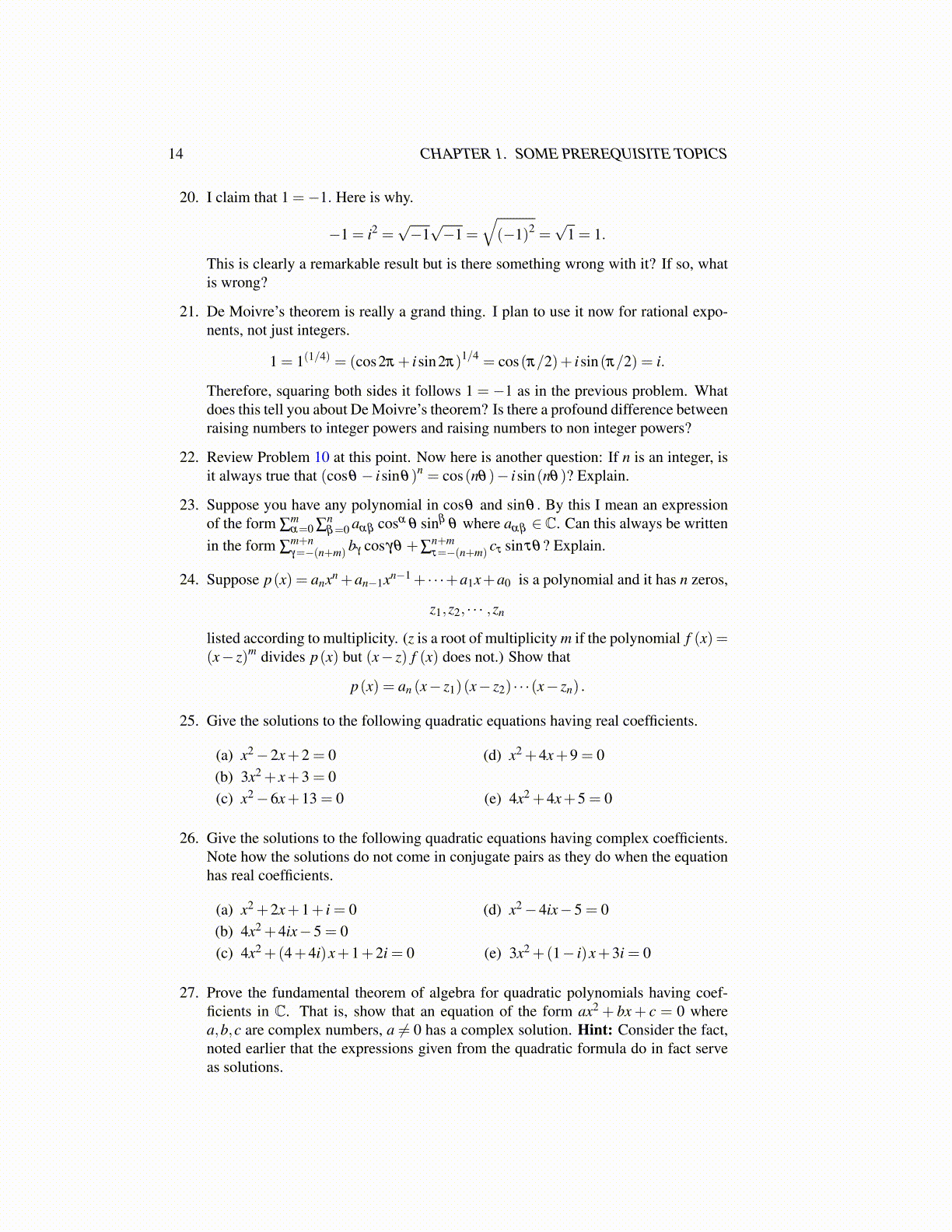
14 CHAPTER 1. SOME PREREQUISITE TOPICS
20. I claim that 1 =−1. Here is why.
−1 = i2 =√−1√−1 =
√(−1)2 =
√1 = 1.
This is clearly a remarkable result but is there something wrong with it? If so, whatis wrong?
21. De Moivre’s theorem is really a grand thing. I plan to use it now for rational expo-nents, not just integers.
1 = 1(1/4) = (cos2π + isin2π)1/4 = cos(π/2)+ isin(π/2) = i.
Therefore, squaring both sides it follows 1 = −1 as in the previous problem. Whatdoes this tell you about De Moivre’s theorem? Is there a profound difference betweenraising numbers to integer powers and raising numbers to non integer powers?
22. Review Problem 10 at this point. Now here is another question: If n is an integer, isit always true that (cosθ − isinθ)n = cos(nθ)− isin(nθ)? Explain.
23. Suppose you have any polynomial in cosθ and sinθ . By this I mean an expressionof the form ∑
mα=0 ∑
nβ=0 aαβ cosα θ sinβ
θ where aαβ ∈C. Can this always be writtenin the form ∑
m+nγ=−(n+m)
bγ cosγθ +∑n+mτ=−(n+m)
cτ sinτθ? Explain.
24. Suppose p(x) = anxn +an−1xn−1 + · · ·+a1x+a0 is a polynomial and it has n zeros,
z1,z2, · · · ,zn
listed according to multiplicity. (z is a root of multiplicity m if the polynomial f (x) =(x− z)m divides p(x) but (x− z) f (x) does not.) Show that
p(x) = an (x− z1)(x− z2) · · ·(x− zn) .
25. Give the solutions to the following quadratic equations having real coefficients.
(a) x2−2x+2 = 0(b) 3x2 + x+3 = 0(c) x2−6x+13 = 0
(d) x2 +4x+9 = 0
(e) 4x2 +4x+5 = 0
26. Give the solutions to the following quadratic equations having complex coefficients.Note how the solutions do not come in conjugate pairs as they do when the equationhas real coefficients.
(a) x2 +2x+1+ i = 0(b) 4x2 +4ix−5 = 0(c) 4x2 +(4+4i)x+1+2i = 0
(d) x2−4ix−5 = 0
(e) 3x2 +(1− i)x+3i = 0
27. Prove the fundamental theorem of algebra for quadratic polynomials having coef-ficients in C. That is, show that an equation of the form ax2 + bx+ c = 0 wherea,b,c are complex numbers, a ̸= 0 has a complex solution. Hint: Consider the fact,noted earlier that the expressions given from the quadratic formula do in fact serveas solutions.